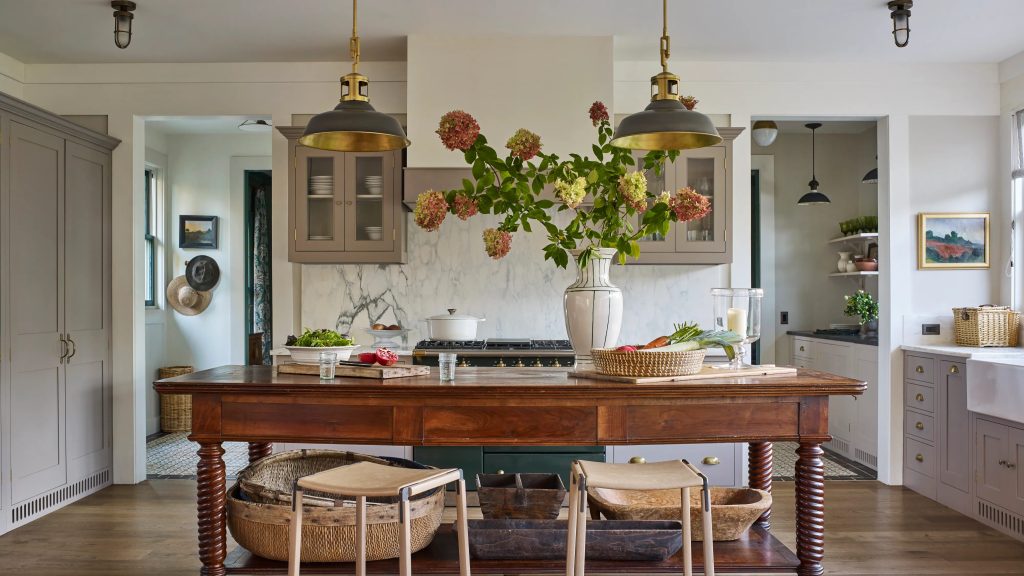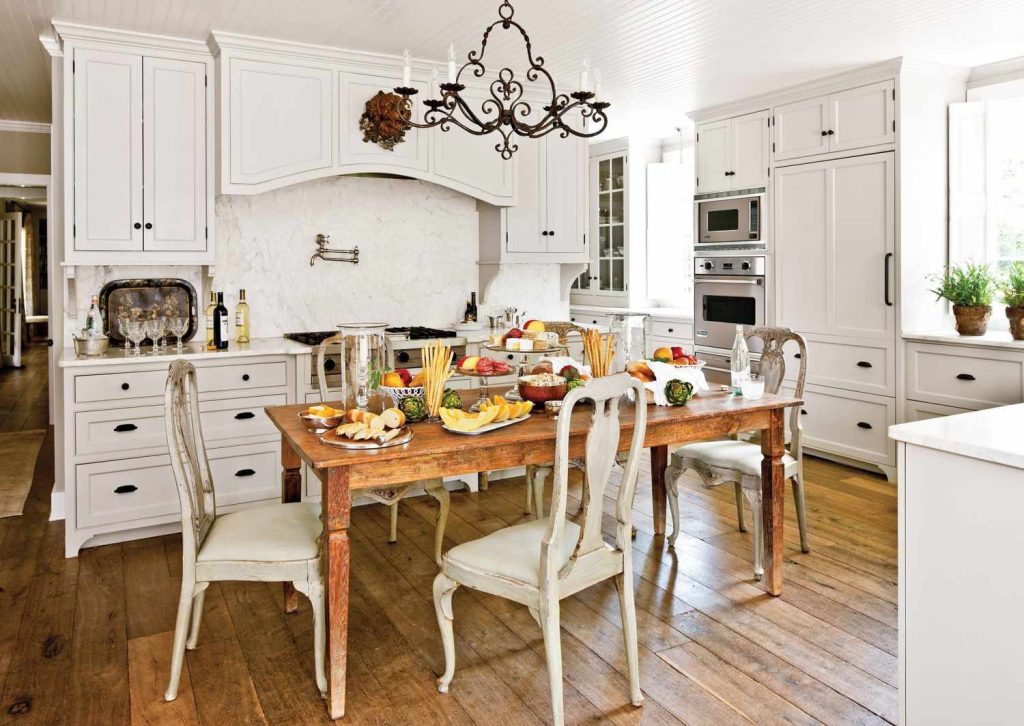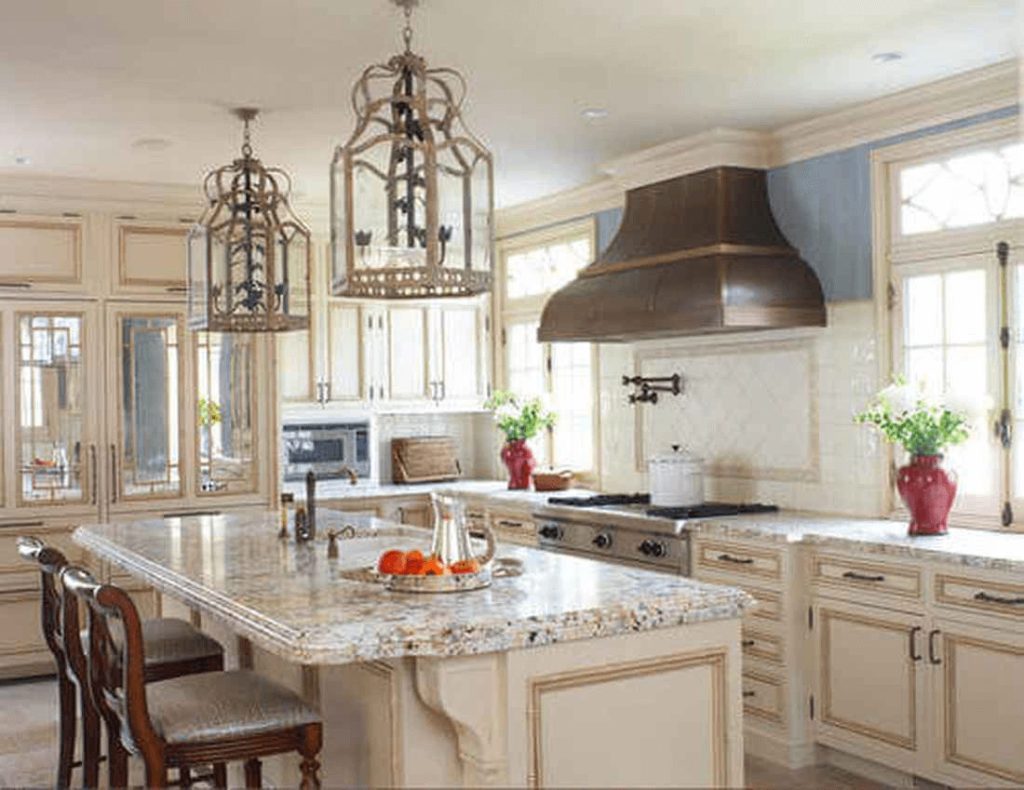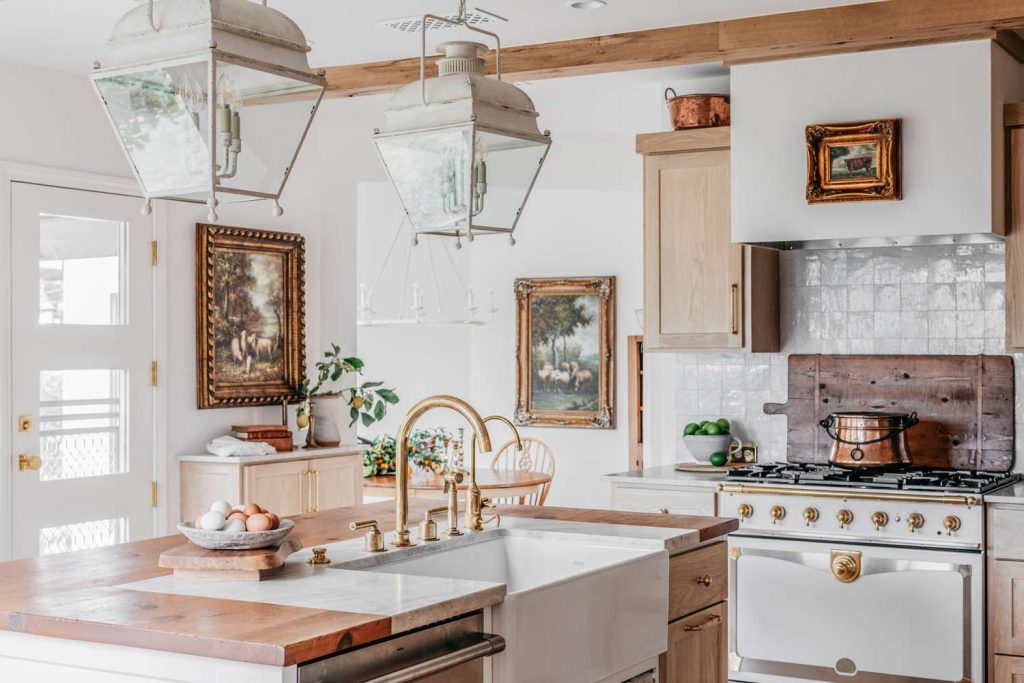The quintessential French country kitchen embodies a captivating amalgamation of rustic simplicity and sophisticated design, transporting us to the picturesque landscapes of Provence. These enchanting spaces are more than mere culinary workstations; they are narrative tapestries woven with history, warmth, and an ineffable sense of comfort.
French Country Kitchens
With their distinctive blend of weathered textures, soft color palettes, and elegant yet unpretentious design elements, French country kitchens represent a design philosophy that celebrates authenticity, craftsmanship, and the art of lived-in beauty.
1. Classic Provençal Stone Kitchen

French country kitchens often begin with a foundational design that celebrates natural materials, and nowhere is this more evident than in the classic Provençal stone kitchen. Here, exposed stone walls create an immediate connection to the region’s architectural heritage, bringing a sense of timelessness and durability to the space.
The stone walls serve as more than just a backdrop; they become a central design element that infuses the kitchen with character and depth. Soft, muted tones of beige, cream, and light gray create a harmonious palette that reflects the natural landscape of southern France. These walls are typically left slightly rough and unfinished, showcasing their organic texture and emphasizing the kitchen’s rustic roots.
2. Farmhouse Wood-Centric Design

Wood plays a pivotal role in French country kitchen design, embodying the region’s agricultural traditions and connection to the natural world. In this style, substantial wooden elements are strategically incorporated to create warmth and visual depth.
A large wooden farmhouse table might serve as the kitchen’s centerpiece, reminiscent of family gatherings and communal meals. Exposed wooden beams on the ceiling add architectural interest and reinforce the kitchen’s rustic character. The wood is typically chosen in natural, warm tones—think oak, pine, or chestnut—and often left with a slightly weathered finish that suggests years of loving use.
3. Soft Color Palette Elegance

The color scheme in French country kitchens is a delicate dance of soft, muted tones that evoke the lavender fields and sunlit landscapes of Provence. Pale blues, gentle greens, warm creams, and soft whites dominate the palette, creating an atmosphere of tranquility and understated sophistication.
These colors are not just visual choices but emotional statements. They reflect the gentle light of the French countryside, bringing a sense of calm and spaciousness to the kitchen. Pastel hues are often applied through painted cabinetry, ceramic tiles, or decorative elements, creating layers of subtle visual interest.
4. Vintage Ceramic and Copper Accents

Accessories in a French country kitchen are carefully curated to tell a story of tradition and craftsmanship. Vintage ceramic pitchers, hand-painted plates, and gleaming copper cookware are not mere decorations but functional art pieces that connect the space to its cultural roots.
Copper pots hanging from pot racks or displayed on open shelving add a warm, metallic glint that contrasts beautifully with softer elements. Hand-thrown ceramic pieces in creamy whites and soft blues contribute to the kitchen’s artisanal aesthetic, each item seemingly carrying its own history and emotional resonance.
5. Open Shelving and Display Spaces

Storage in French country kitchens transcends pure functionality, becoming an opportunity for aesthetic expression. Open shelving allows for the display of cherished dishware, cookbooks, and decorative items, transforming practical storage into a design feature.
Wrought iron brackets, weathered wood planks, and carefully arranged collections create visual narratives within the kitchen. These display spaces are not about perfection but about personal story and lived experience, reflecting the French appreciation for beauty in everyday objects.
Related Guide: 13 Country Kitchen Ideas
6. Natural Light and Airy Spaces

Lighting is crucial in French country kitchen design, with an emphasis on maximizing natural illumination. Large windows with minimal treatments allow sunlight to flood the space, creating an open, breathable environment that feels connected to the outdoors.
Soft, diffused light highlights the kitchen’s textural elements—stone, wood, ceramic—creating a luminous atmosphere that changes subtly throughout the day. Vintage-inspired light fixtures with delicate metalwork or ceramic bases complement the natural lighting, adding another layer of visual interest.
7. Integrated Appliances and Modern Functionality

While deeply rooted in tradition, contemporary French country kitchens successfully blend historical aesthetics with modern functionality. Appliances are often integrated or concealed behind cabinetry that mimics traditional design, maintaining the kitchen’s classic appearance.
Refrigerators might be disguised behind panels matching surrounding cabinetry, and modern induction cooktops can be seamlessly incorporated into traditional wooden islands or stone countertops. This approach ensures that the kitchen remains true to its historical inspiration while meeting contemporary lifestyle needs.
8. Herb Gardens and Natural Elements

The connection to nature is paramount in French country kitchen design. Interior herb gardens, potted lavender, and fresh flower arrangements are not just decorative but integral to the kitchen’s identity.
Windowsills often host small herb gardens, providing both culinary ingredients and a living, green element that connects the interior space to the external environment. Terracotta pots, woven baskets, and natural fiber accessories reinforce this organic, earthy aesthetic.
9. Textural Contrast and Layering

Texture is a fundamental design principle in French country kitchens. Multiple materials and finishes are layered to create depth and visual complexity. Rough stone might be juxtaposed with smooth ceramic, or weathered wood might contrast with polished metal surfaces.
This deliberate play of textures creates a rich, multidimensional environment that feels both sophisticated and wonderfully lived-in. Each surface tells a story, inviting touch and exploration.
10. Personal and Evolving Spaces

The most compelling French country kitchens are those that feel personal and continuously evolving. They are not static museum pieces but living spaces that adapt and change with their inhabitants.
Family photographs, inherited cookware, hand-written recipe cards, and generational cooking tools contribute to the kitchen’s unique character. These personal touches transform the space from a mere design concept into a genuine home environment.
Conclusion
French country kitchens represent far more than an interior design style—they are a philosophy of living that celebrates simplicity, craftsmanship, and connection.
By embracing natural materials, soft color palettes, and personal storytelling, these spaces create environments that are simultaneously elegant and profoundly comfortable.
Whether situated in rural Provence or urban settings worldwide, they remind us that true beauty emerges from authenticity, history, and a deep appreciation for life’s simple pleasures.

